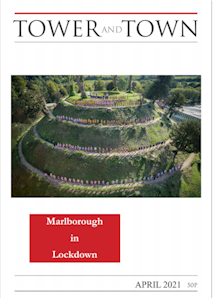

Tower and Town, April 2021 (view the full edition) (view the full edition)Bird Song"When birds do sing, hey ding a ding, ding!" When the words of the Elizabethan madrigal "It was a lover and his lass" were written the seasons were sharply defined, and so they were I reckon in my childhood too-it snowed in the winter, birds returned on regular dates in spring and fat conkers appeared in September. Now seasonal changes are more unpredictable and confusing and with global warming strange things are confounding tradition: some of our summer visitors have been overwintering in recent decades, turning up in our gardens and on bird feeders. Our birds start singing well before spring arrives: the dunnock, robin, mistle thrush and song thrush can be heard in January, even an early blackbird on warm days. The green woodpecker "yaffles" in February and both great and lesser spotted woodpeckers have begun their drumming in Savernake Forest, the latter now a rarity. In March things begin to accelerate with the arrival of the first chiffchaffs and blackcaps, their gentle warblings drowned out by the explosive song of the Cetti's warbler. First recorded in the 1960's in the U.K. this skulker it is now a local resident in tangled waterside vegetation along the River Kennet. The skylark, as Meredith's poem puts it, "rises and begins to round, he drops the silver chain of sound" beautifully evoked in Vaughan Williams's "Lark Ascending." In April the warblers arrive and establish their territories: willow and garden warblers, whitethroats and lesser whitethroats, sedge and reed warblers.  The dawn chorus is best heard in late April to the end of May: this year "Dawn Chorus Day" falls on 3rd May. One Suffolk birder listed, from 4.00 -6.00 a.m., his "Cast in order of Appearance", a total of 25 species starting up minute by minute: robin, song thrush, dunnock, blackbird, woodpigeon, wren, blackcap, great tit, cuckoo, chaffinch........ We all have our favourites: the robin, for example, that sings all year round, even at night, fooled by the artificial light from street lamps. As a musician I like the way the song thrush repeats his pretty patterns, like an industrious chorister. Then there's the wren, punching above his weight with deafening roulades of sound. The grasshopper warbler is a late evening performer, with its eerie, insect-like reeling song. That's the time when the nightingale, now much reduced in numbers in Wiltshire, starts up his beautiful,chortling strains. Robin Nelson |